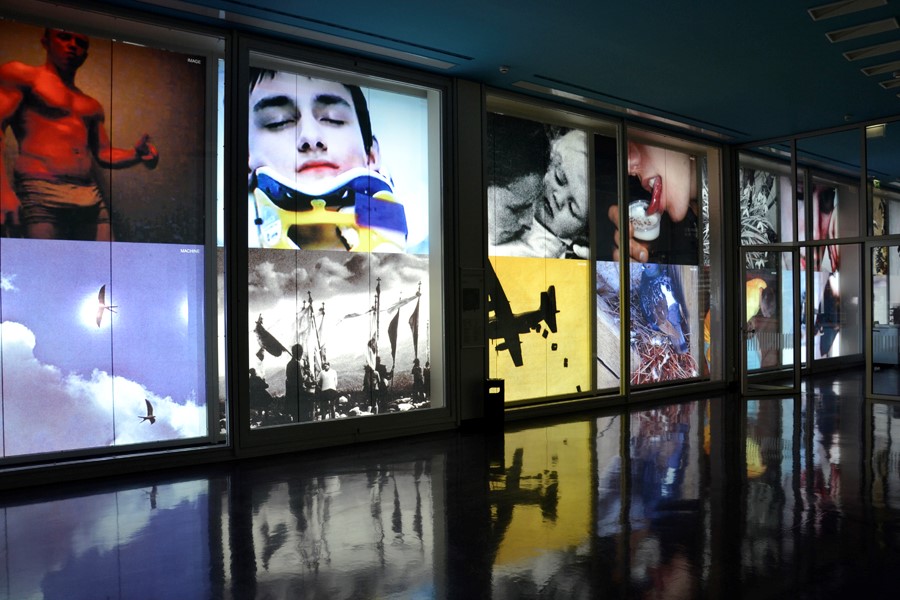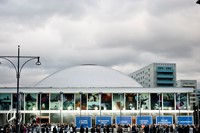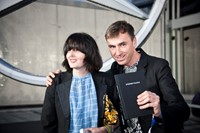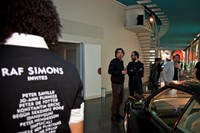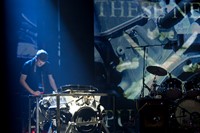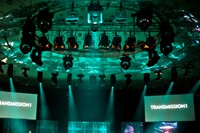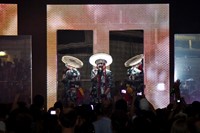Last weekend in Berlin, Raf Simons brought together his favourite inspirational individuals in art, design, music and dance, including Peter de Potter, Michael Clark and Peter Saville, for a three-day avante-garde festival...
If you saw the Michael Clark Company performing to Heroes, in Berlin, whilst the enigmatic video of Bowie burned like a candle in the background, chances are the tunnels of your mind would cave in and you'd be fighting back the tears. Which is what happened on Sunday July 17, the closing night of the Raf Simons-curated Transmission1 event, in collaboration with Mercedes-Benz's The Avant/Garde Diaries.
Clark's performance was described by one guest as "the moment that gave everything context." Though the three days of creativity which had unfolded before international eyes were in no way short of once-in-a-lifetime highlights.
Sunday afternoon's Show and Tell: Pop Music talk being one of them, chaired by writer, editor and creative director Jo–Ann Furniss, with Tim Blanks and the brilliant broadcaster Paul Morley. Musing how media preconception and a lack of breathing space is Pop's big threat; how social networking is a linguistically reductive fad and how creativity should retain its impetus – even when the machines finally take over. If in summary that sounds a little dystopian, it wasn't – the show was constructive and impassioned, a reminder that Britain has the best cultural commentators in the world who don't let their well-flexed intellect or talent get in the way of self-depricating charm.
Peter De Potter's mammoth Image Machine installation saw his art in a physical context for the first time. Coating the windows, his luminous photographs captivated onlookers inside and out, reacting impressively with pavement-pounding Berliners on the street as well as knowing culture-vultures.
"They're 32 works from my series 'I am an image machine'," De Potter told AnOther. "I really wanted to have this public aspect about it, that would be visible from the street, in the same way that I show my work on the internet where it's equally up for grabs for anyone passing by. The series is about the way images nowadays, thanks to the current internet generation, have become free of reference, free from history, free from authorship – context, even content isn't as important anymore as the emotional charge the image brings. Nowadays we use images primarily to communicate on an emotional level, like 'what you see is what you feel'. This approach is very very close to the way I always have perceived and used images. The main purpose the works have is to have an emotional value for the viewer, they're not about me, more about... the melancholy of the computer, I guess."
And what does the artist think of the city? "When I'm in Berlin, daytime feels like nighttime, and nighttime feels like daytime," the Belgian continued. "Not in the sense that everything is reversed, but to me, the city seems to be dizzy and dozy and dreamy when the sun is up, and wide-eyed when evening starts to fall. It's a big, black wet dog and he's a friendly sniffer."
Elsewhere, Germaine Kruip's modern sculptures harmonised in their environment. The artist also worked with Simons' catwalk lighting designer Thierry Drefus to surround Mercedes-Benz's A-Class concept car in a barely-there box. Peter Saville juxtaposed by displaying his own 1998 Mercedes SL 500, Joy Division leaking from the stereo, in an act as concise as one of his LP sleeves.
These New Puritans played a gig with vintage car engines, Goose nailed their reputation as Belgium's thumping electro saviours, DJ Hell got everyone dancing and Fischerspooner engaged the crowd over two nights, as bloggers Begüm Sekendiz Boré and Peter Henderson interpreted the event online, from bespoke interiors, in their distinct ways.
And beyond the timetable, there was a very social draw: smoking indoors. In an age where sparking-up is treated with universal disdain, it's easy to forget how the bad act is a cementer of bonds and a romantic, social ritual. How Raf Simons we were able to do it, then: he's spent his career orchestrating communities. Even that subtle performance was considered.
Text by Dean Mayo Davies
